By Colin G. F. Thomas
 Choosing
the
subject of the Durotriges is perhaps
a little ambitious. However, the coins of these pre-Celtic tribes do
hold a
certain fascination. These coins cannot be dated to any recognized time
scale,
at least not accurately, but a period of mid 1st Century BC
to mid 1st
Century AD seems to be common. Unfortunately a more defined dating
period is
not, at this stage, possible.
Choosing
the
subject of the Durotriges is perhaps
a little ambitious. However, the coins of these pre-Celtic tribes do
hold a
certain fascination. These coins cannot be dated to any recognized time
scale,
at least not accurately, but a period of mid 1st Century BC
to mid 1st
Century AD seems to be common. Unfortunately a more defined dating
period is
not, at this stage, possible.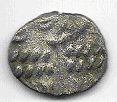 The
Durotriges people are steeped in
mystery even though it is known that they existed and also known where
they
resided. The county of Dorset in southern England and the western part
of
Wiltshire and eastern part of Somerset seem to have been the boundaries
of
these people, with their main centre situated in what is now known as
Dorchester.
The
Durotriges people are steeped in
mystery even though it is known that they existed and also known where
they
resided. The county of Dorset in southern England and the western part
of
Wiltshire and eastern part of Somerset seem to have been the boundaries
of
these people, with their main centre situated in what is now known as
Dorchester.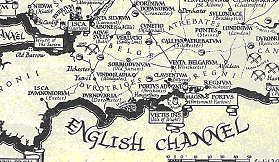 Coins
of the Durotriges have no known text
on them nor do they represent figures of human beings and this makes it
all the
more difficult for the numismatist to identify and catalogue. One
aspect
however is quite common on the said coinage. A stylized disjointed
horse figure
usually, but not always, appears on the reverse of a great number of
coins. Of
course other Celtic coinage depicts such figures but the Durotrigan
coinage appears to be of a cruder manufacture. Many are
struck in debased silver – billon staters – but gold and silver coins
do exist.
Coins
of the Durotriges have no known text
on them nor do they represent figures of human beings and this makes it
all the
more difficult for the numismatist to identify and catalogue. One
aspect
however is quite common on the said coinage. A stylized disjointed
horse figure
usually, but not always, appears on the reverse of a great number of
coins. Of
course other Celtic coinage depicts such figures but the Durotrigan
coinage appears to be of a cruder manufacture. Many are
struck in debased silver – billon staters – but gold and silver coins
do exist.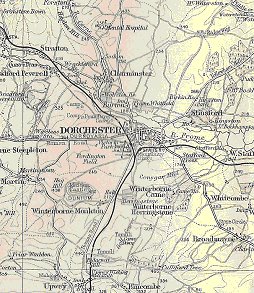 Maiden
Castle, Britain’s largest hillfort, was built prior to the period of
occupation
of the Durotriges, but was manned by
them as a major centre of activity. Today, over 2,000 years later, the
fort
still stands as a testament to the abilities of those people. It covers
a vast
area with terraced levels and moats guarding the apex of the structure.
It
would have been a very easy place to defend and indeed battles have
been fought
there.
Maiden
Castle, Britain’s largest hillfort, was built prior to the period of
occupation
of the Durotriges, but was manned by
them as a major centre of activity. Today, over 2,000 years later, the
fort
still stands as a testament to the abilities of those people. It covers
a vast
area with terraced levels and moats guarding the apex of the structure.
It
would have been a very easy place to defend and indeed battles have
been fought
there.Excavation in recent times has revealed burial sites in the vicinity where warriors had fallen in battle.
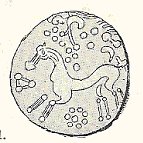 With
this in mind, one can only speculate about the origins of the hillside
horse of
Uffington in Berkshire. This massive carving, similar in design to the
coinage
as mentioned, stretches an incredible 114 metres by 40 metres high and
must
have had some significance to those who painstakingly made it. Perhaps
the
horse was an indication that religious ceremonies had taken place.
With
this in mind, one can only speculate about the origins of the hillside
horse of
Uffington in Berkshire. This massive carving, similar in design to the
coinage
as mentioned, stretches an incredible 114 metres by 40 metres high and
must
have had some significance to those who painstakingly made it. Perhaps
the
horse was an indication that religious ceremonies had taken place.Do the marks on these coins represent a counting mechanism or the recording of some event or do they reflect a division of the year or the seasons? Does the disjointed horse depict a deity, something to be revered or worshipped? Could the button forms show a harvest where harvest might refer to wealth? And the ears of wheat may count for a healthy cache of food, again meaning wealth. This, of course, is just speculation but it is interesting to imagine that the meaning of the symbols on these coins stand for something vital to the people who produced them. Could these people have copied signs from the night sky and what value was put on these coins one might inquire.
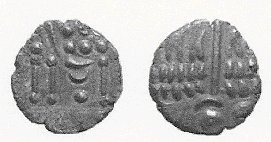
Photo Courtesy of Brian Beresford of the Havering Numismatic Society, England
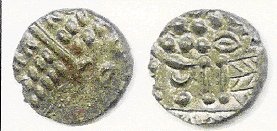 Photo
Courtesy of Mike
R.Vosper
Photo
Courtesy of Mike
R.Vosper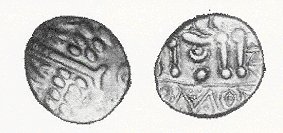 Photo
Courtesy of Mike R.
Vosper
Photo
Courtesy of Mike R.
Vosper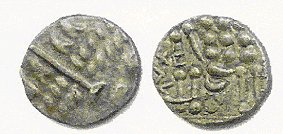 Photo
Courtesy of Mike R. Vosper.
Photo
Courtesy of Mike R. Vosper.As previously stated, to fully understand the Durotriges people more study needs to be undertaken. Precious little information is evident and the coinage, as in many cases throughout history, could be a major factor in delving into the lives of these people. It is known that apart from a mint established at Hengistbury Head, a well established trading centre existed. Merchandise arriving from Europe by boat supplied various commodities not available locally. It was by no means a one way trade as pottery, mentioned previously, could be exchanged for items needed. To date, and I stand to be corrected on this statement, no Durotrigan coinage has been found outside the immediate area occupied by these people. There are, to date, no reports of this distinctive coinage having been found in Europe. Did money exchange hands for these commodities or was barter the media used in transactions ? It would appear that the said coinage remained in England and was used purely in the Dorset area. And this is rather surprising considering that the Uffington horse, earlier mentioned, could have been the inspiration for the disjointed horse design on coinage. Certainly the effigy carved on the hillside in Berkshire was done long before the Durotriges established themselves in the Dorset area. Speculatively, was this horse seen by these people and copied on to the coinage and who were the mint masters of the time ? The coinage leaves us with more questions than answers.
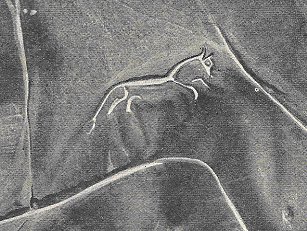
The Uffington Horse in Berkshire
This picture was taken c 1938 and
the figure has undergone certain chnages since that date
Hill
Forts Maiden Castle
Hod Hill
Poundbury Rawlsbury
Eggardon Spetisbury
Abbotsbury
Badbury Pilsdon Pen
Banbury South Cadbury
Hambledon Hill Battlesbury
Note:- The main horde of coins found were discovered at Badbury, Hod
Hill, Maiden Castle and south of the city of DForchester, and on the
Isle of Weight. Over 800 coins were unearthed at Badbury
Weapons Animal Bones
It
is perhaps sad that bodies of these people, other than skelatal remains
that is, have not been unearthed. How much more would researchers
have learned
had
figures similar to those of Tollund Fen Man, Grauballe Man, Lindow Man
or
Elling Woman been discovered. These
bodies were well preserved and date back to the time of the Durotriges
people.
Carbon dating has placed these incredible finds between the years
290BCE and 119CE,
the precise time span pre-mentioned. Re-construction of facial features
of some
of these bodies has created for the historian and student alike a focal
point
by which real interaction between the past and present can intermingle.
To understand
that these people actually walked this earth over 2000 years ago is a
sobering
thought and the Durotriges people are no exception to this scientific
observation. What was it like to live in those times ? How did they
feel about
one another ? What was their everyday lives like, what were their
worries and
issues of the day ? How did they interact with neighbouring tribes ?
Was health
an issue and at what age was it considered to be old ? Certainly those
skeletons that have been found were not old by today’s standards,
arguably 35
to 40 years at most when in the 21st century one can expect
to
double that figure.
The Search for the Durotriges” by Martin Papworth
‘Romantic Britain’ by
Tom
Stephenson
‘The Celts’ by Peter
Berresford-Ellis
‘Written in Bones’
edited by
Paul Bahn
‘The Celts – History and
Treasures of an
Ancient Civilization’ text by Daniele Vitali
‘Swanage and South
Dorset
Illustrated Guide
Book’ 1933/34
‘Britain BC’ by Francis
Pryor
‘Seahenge’ by Francis
Pryor
‘The Practical
Archaeologist’
by Jane
McIntosh
‘Coins of the England
and the
United
Kingdom’ by Spink
‘The Coins of Great
Britain and
Ireland’ by
Thorburn & Grueber (1905)
BBC
– DVD production ‘In
Search
of Myths
and Heroes’ presented by Michael Wood